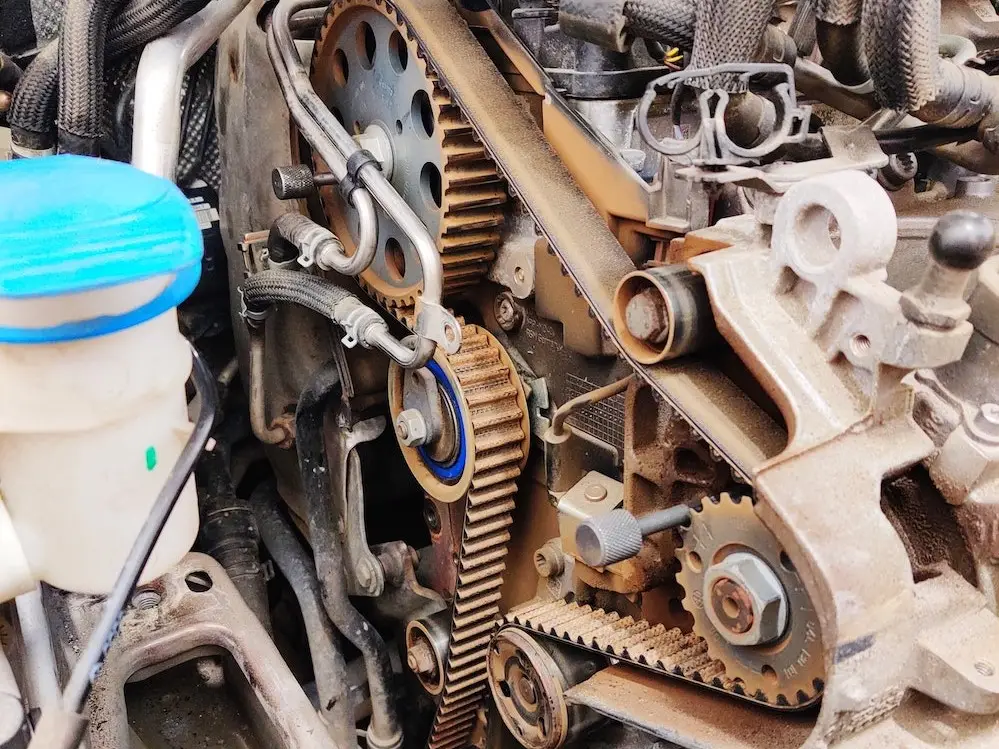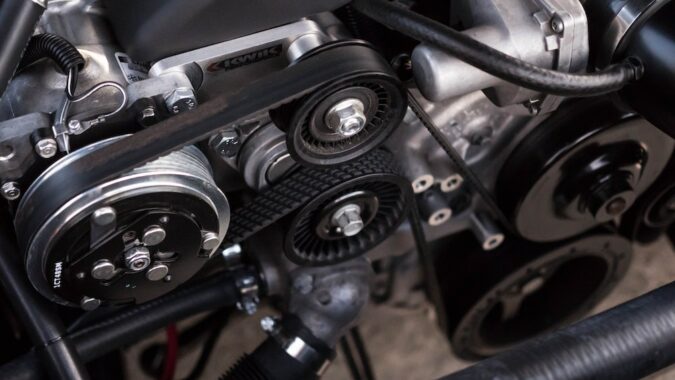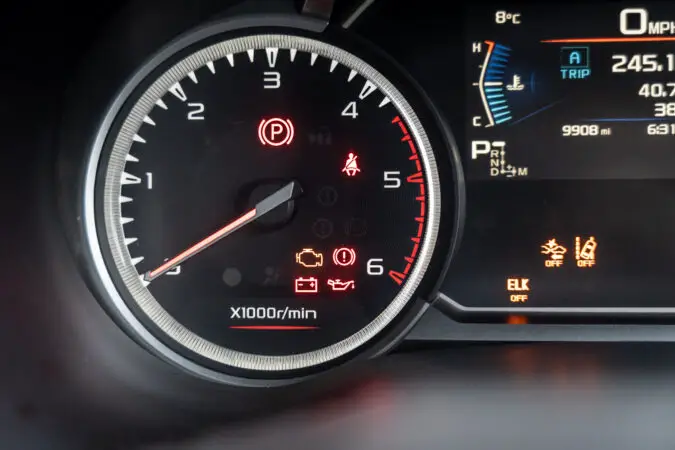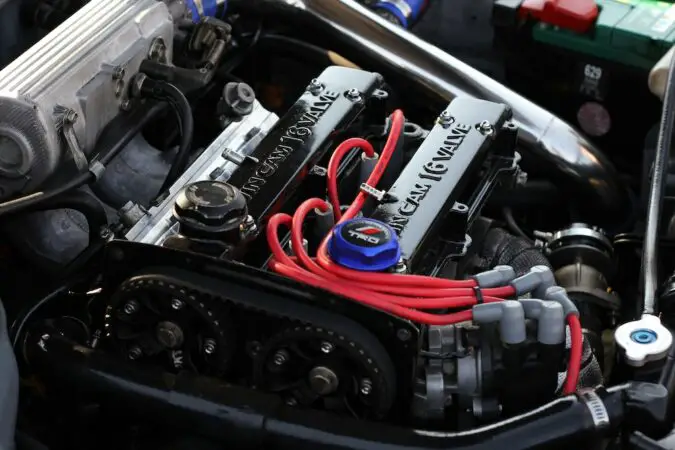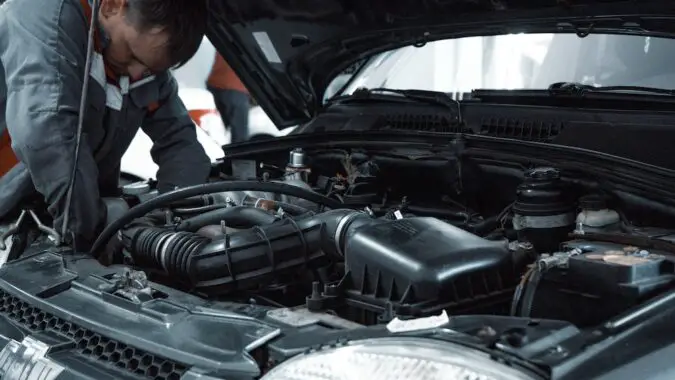Have you started hearing some strange noises coming from behind the timing cover and you want to learn the bad timing belt symptoms? If this is the case, then you are at the right place because there will be a lot to cover in this topic where we will learn how you can diagnose a bad timing belt.
The timing belt is one of the most important components in your vehicle. Why I’m saying this? Well, because it is true. Without a timing belt in proper working order, you basically put the life of your engine in great danger.
The engine needs this belt in order to work properly. It’s not like in the case of the drive belt that can tolerate snapping. A broken timing belt could easily turn your engine into scrap. So, this is why you need to be aware of this component and its importance when it comes to the work of the engine and we are going to help you out with that.
First, we are going to learn what is a timing belt and why it is so important. Then we will learn the bad timing belt symptoms and how you can diagnose a bad timing belt on your vehicle. Then we will discuss the timing belt replacement and the costs involved in this work. So, if you want to learn more, please follow along.
What Is A Timing Belt?
Now before we dive into the bad timing belt symptoms, we first need to clear out some important topics. This is needed because there are a ton of people who are reading the article and are not quite familiar with what the timing belt is.
Also the replacement interval, and the serpentine belt vs timing belt. So, in the following few chapters, we will cover that briefly before we dive into the symptoms.
Nevertheless, a timing belt is a special belt that is equipped in some cars. Not all cars have it, some of them are using timing chains. In fact, these are the two designs that compete with each other. They both do the same thing though, they link the crankshaft at the bottom with the camshafts that are located at the top of the engine.
What is useful to note is that timing belts are only used in overhead camshaft engines only which are interference engines. This means that the perfect timing needs to be always there in order so the pistons and valves do not collide with each other.
If they do, there will be a ton of damage. While on the other hand, timing chains are used in both interference and non-interference engines. So, you get the point.
The timing belt is a belt that is really heavy duty and designed to withstand a ton of stress during its lifetime and prevent engine damage. It has teeth that are somewhat big. And these teeth are really important so the belt doesn’t slip and make you lose the timing.
This is how you will recognize this belt. In addition to this, this belt is mounted behind the timing cover. But what are the bad timing belt symptoms? More on that in a bit.
Can A Timing Belt Ruin Your Engine?
Now let’s answer another interesting question before we learn about the bad timing belt symptoms. And that is whether or not a timing belt can ruin your engine?
And the short answer to this question is yes, a timing belt can ruin your engine if it snaps. So, why is this the case?
Well, this is the case because the timing belt as its name implies, is there to keep the engine timing in check. So, this means that the alignment of the pistons and the valves needs to be always in perfect condition.
When the valves open, the piston should retract. And then when the valves close, the piston should go to its maximum length. All, this process happens in a fraction of a second.
So, if the timing of this process is not perfect, the pistons and the valves will collide with each other. And you can imagine what will happen when metal collides with metal.
The valve will get bent and the pistons damaged. Sometimes even the cylinder walls will take a toll. And when this happens, the engine is destined for the scrapyard. So, this is why you need to consider the timing belt replacement as a really essential thing. You need to learn how to read the bad timing belt symptoms and determine if this belt is bad or not.
But what is the right interval to replace this timing belt? Well, more on that we are going to cover in the following chapter where we will discuss all about this replacement interval so you get a good perspective of when it is the right time to do this replacement on your car.
Timing Belt Replacement Interval
Now as we learned what is the timing belt and its importance, we need to cover another topic before we dive into the bad timing belt symptoms. And that is the timing belt replacement interval. When you should replace this timing belt on your vehicle?
The recommended interval for this service is somewhere between 60,000 and 100,000 miles. This is the sweet spot when it comes to doing this service on your car. Replacing it when it hits 60,000 miles will be close to ideal if you want to prevent this belt from snapping.
Also, another important aspect to take care of is the age of the belt. This belt is made out of rubber and rubber cracks. So, you can expect some problems with cracking to appear even if the belt hasn’t reached 60,000 miles. Replace the belt if it’s more than 7 years old.
Another thing to add is if you purchase a used vehicle and you are not aware when this belt was replaced is to replace it if you notice that it is faded and has cracking development on it. Now let’s discuss another topic before we dive into the bad timing belt symptoms.
Serpentine Belt VS Timing Belt
Now before we cover the bad timing belt symptoms, let’s cover another important topic which is the serpentine belt vs timing belt. Or a drive belt vs timing belt as would some people would call it. How these two belts are different from one another?
Well, they are both belts but serve different purposes on the car. But how you can tell one from the other? Let’s explain.
The timing belt is a belt that sits behind the timing cover. This means that it is not visible unless you remove this cover to inspect this belt. And serves the purpose of maintaining the proper timing of the engine and keeping the engine working well.
On the other hand, the drive belt also known as a serpentine belt is visible right when you open the hood. You will notice this belt and see it goes around different pulleys. Like the alternator pulley, the water pump, power steering pump, and AC. You get the point.
The serpentine belt is there to power up the accessories in the car by transferring the rotational energy from the crankshaft. And if this belt snaps, it’s not that big of a problem like in the case with the timing belt when you get engine damage. But what are the bad timing belt symptoms? Well, that’s what we are going to cover next.
Symptoms Of Bad Timing Belt
Now let’s cover the symptoms of a bad timing belt or the bad timing belt symptoms as some people would call them.
How you can tell if the belt has failed on your car? What symptoms this component produces and can make the diagnostics process a lot easier? Let’s elaborate in the following chapters.
1. Check Engine Light
Now let’s get into the first in our list of bad timing belt symptoms and this symptom is the check engine light.
A check engine light as a light doesn’t mean a lot. It indicates that there is a problem inside of your engine and this problem needs to be addressed. So, you better diagnose the problem and see what is really the cause behind this light.
For this purpose, you will need an OBD2 scanner. And with the scanner, you will be able to diagnose the problem. But what is unfortunate is that you will not get codes concerning the timing belt since the belt is not connected to the computer. In most cases, you will get a P0300 code that indicates a random misfire. Or some codes concerning the camshafts.
So, it is up to you based on these bad timing belt symptoms to determine if the belt is broken or not.
2. Bad Timing Belt Sound
The next in our list of bad timing belt symptoms that we would like to cover is the bad timing belt sound. Also known as a ticking sound.
Whenever the timing belt has skipped timing, you will notice a ticking noise coming from the top of the timing cover.
In fact, this is a great symptom to diagnose this problem since you are audibly informed that there is something going on inside of the engine. So, you better check what is causing this ticking sound and perform a timing belt replacement before it gets late and the engine destroys itself. Now let’s move to the next bad timing belt symptoms.
3. Engine Misfires
The next in our list of bad timing belt symptoms that we would like to cover is the symptom when you experience engine misfires. But what are misfires in general?
Well, a misfire can be considered to be any type of combustion that isn’t properly timed out. So, if you have a premature explosion inside of the cylinder or a delayed one, it will be considered an engine misfire.
These misfires when heard from the top of the engine can be heard as ticks and at the exhaust pipe, there will be pops and bangs.
Also, the P0300 code indicating random misfires will be there. Or any code that indicates a misfire on a specific cylinder. Such as P0303 which indicates a misfire on cylinder number 3 for example. So, be aware of these subtle bad timing belt symptoms.
4. White Smoke From Exhaust
The next in our list of bad timing belt symptoms is the situation with the white smoke from the tailpipe.
Cars with messed-up timing can smoke a lot. So, if you notice this issue with your car, then you should really consider this as a symptom of a bad timing belt.
Mainly because it is closely associated with poor work of the camshafts and engine misfires. The whole timing of the engine will be off if the timing belt is missing a few teeth. This will indicate a wrong timing by a few degrees. Which is quite a lot if you are asking me.
So, if the engine smokes, then you need to visually inspect the engine and see if there is damage to the belt. And that’s what we are going to cover in the next chapter of the bad timing belt symptoms.
5. Visible Damage To The Belt
The next on our list of bad timing belt symptoms are the visible damage to the timing belt. A timing belt can get damaged and skip some timing.
If the timing belt is too worn out you can expect that this belt is going to have some of its teeth missing on it. So, a detailed check is essential to determine that this belt is in good condition unless you want to get engine damage that is not repairable.
Also, cracking is notorious to start to develop on these timing belts. Slight cracks should alarm you and indicate that you need to perform a timing belt replacement. A ton of people are not aware of these things because the timing belt is hidden behind the timing cover and they don’t try to remove it once to see if their belt is in decent shape.
So, we encourage you to do this check every 5,000 to 10,000 miles and see the condition of this component. Now let’s move on to the last of the bad timing belt symptoms.
6. Engine Damage
And the last in our list of bad timing belt symptoms is the engine damage. This is really something that you don’t want to happen to your car because the engine damage from this problem can be slight in some cases but in some, it can send your engine to the scrap yard.
Why I’m saying this? Well, because sometimes this damage is only slight if the timing is off by a few degrees. A few valves will get bent and the car will misfire and smoke.
But sometimes when the belt snaps completely, it will destroy your engine completely on the inside. The valves and the pistons will collide at a great force that will mangle up everything inside of the cylinder.
And frankly, you don’t want to get to this point where the damage is too severe and the only way around it will be to get a new engine. So, beware of these bad timing belt symptoms. But what about the timing belt replacement? Well, more on that in the following chapter.
Timing Belt Replacement
We have covered the bad timing belt symptoms. Now let’s discuss timing belt replacement. This is another important topic that you need to know when it comes to this type of belt. So, when this replacement is needed?
Well, this timing belt replacement is needed whenever the belt has over 60,000 miles or 5 to 7 years of age. When the belt reaches these numbers it is worth checking it out and inspecting it for damage.
If there is cracking developed on the belt and there are missing some of its teeth, then this belt is due to be replaced. Don’t wait for the bad timing belt symptoms to show up. Replace this belt before that. It will be much easier for you in the long run since you will prevent complete engine failure on your vehicle.
Another thing that is worth mentioning is the replacement of this belt is not beginner-friendly. These jobs are only left for the most experienced mechanics because this type of job is either you do it right. Or you do it wrong and the engine destroys itself.
This is why we would not recommend this work to beginners because the chances of destroying your engine are really high. Even though, if you follow the manual and align the camshafts and the crankshaft properly at the recommended markings and install the engine you will be good to go.
But still, this work requires experience and not anyone can do it. You need to have at least 1 year of experience working around cars and a decent understanding of how the mechanical components interact with each other. Still, if you want to see how this procedure is done, you can check the video above that we attached.
Timing Belt Replacement Cost
So, we covered the bad timing belt symptoms, now let’s say that you have a worn-out timing belt that needs to be replaced. How much money can you expect to pay to replace this component on your car?
The average timing belt replacement cost is somewhere between $500 and $800. But why so expensive since the part is less than $100?
Well, this is the case because the labor is expensive. And in most cases, it is not only the timing belt. The tensioner, as well as the water pump, also need to be replaced. So, the timing belt and water pump replacement costs are high because of this.
Replacing this pump is quite essential when you are doing this job since you are already there and replacing this pump is a good thing since it can fail and cause you a ton of problems.
Many people are also asking about the timing belt repair cost. In case your belt snaps, how much money can you expect to pay? Well, in the best case, you will pay only for the new part. But in worst cases, you will have to do a major engine rebuild or engine replacement. Something which can cost more than $3,000 in some cases.
Timing Belt Repair: 6 Signs Your Vehicle Needs It
- The timing belt rotates the engine’s cam and crankshaft in sync to ensure each cylinder fires at the appropriate time.
- The timing belt is located under a timing cover near the front of the engine and needs to be replaced periodically.
- Ticking noise coming from the engine could be a sign of a worn-out timing belt, as well as low oil pressure.
- A broken timing belt results in the engine not being able to ignite or turn over, causing serious damage to cylinder head hardware.
- An oil leak near the engine could be a sign that the timing belt is in bad shape, which can lead to engine overheating and other expensive repairs (as you would with a car overheat when AC is on).
- Excessive smoke from the exhaust and strange behavior in RPMs can be signs of timing belt issues, which can lead to costly repairs down the line.
- Auto mechanics recommend replacing the timing belt every 60,000 to 100,000 miles.
- The timing belt is attached by a series of pulleys that go to the engine’s crank and camshaft.
- The crankshaft powers the engine’s connecting rods, while the camshaft operates the cylinder head valves and rocker arm assembly.
- The timing belt cover may come loose over time, causing oil leaks and other issues.
Conclusion
In this article, we have covered quite a bit when it comes to the bad timing belt symptoms. First, we covered what is the timing belt and how it differentiates from the serpentine belt. And also what could happen in this belt snaps.
Then we learned the bad timing belt symptoms and what are the main symptoms when this belt breaks. After that, we covered the timing belt replacement and how much it will cost you.
F.A.Q
Now let’s answer some frequently asked questions.
What Is A Timing Belt
A timing belt is a special belt. This belt gives the top and bottom of the engine to be in perfect sync and work smoothly. This belt is an essential component that keeps the timing in check all the time. Thus, the name timing belt.
Where Is The Timing Belt Located
The timing belt is mounted behind the timing cover. The timing cover is a big plastic cover that is held by a few bolts. On RWD cars the timing cover is in front of you when you open the hood. While in FWD cars the timing belt is on the left side of the engine bay.
What Does A Timing Belt Do
The timing belt is a belt that is keeping the top of the engine and the bottom of the engine in perfect synchronization. Keeping the combustion in check and the timing of the components in check in the process. Thus, the name timing belt. If the timing is off, there will be engine damage.
How To Tell If Timing Belt Is Bad
You can tell that the timing belt is bad by inspecting it. If the belt is bad, you will notice cracking and the belt will miss a few teeth. Still, you will need to remove the timing cover to inspect it. Also, the bad timing belt symptoms which include engine misfires, check engine light, and ticking noises will also be present.
What Are The Symptoms Of A Bad Timing Belt
The bad timing belt symptoms include check engine light with codes that indicate random misfires. Namely, the P0300. Or codes concerning the position of the camshafts. Also, there are audible symptoms such as ticking noises, engine misfires, white smoke from the exhaust, and visible damage on the belt.
How Much Does It Cost To Replace A Timing Belt
On average, the replacement costs about $300 for most cars. But if you also replace the water pump in the process this price can go up to $500 or $800 for some cars. It really depends on how easy the job is since not all cars are the same.

